The poinsettia is much more than just a beautiful decorative plant. For many, its vibrant red symbolises warmth, hope and light during the dark winter months. It reminds us of the things that matter most at this time of year: human closeness, small gestures of appreciation and the sense of security that comes from creating it together.
A companion during Advent
The poinsettia’s story begins in Mexico, but its symbolism has long since spread across the globe, capturing the hearts of people, especially in Europe. Poinsettias are an integral part of the festive season. They make thoughtful gifts and are a traditional decorative plant, accompanying us throughout Advent. The poinsettia’s origin and meaning unite stories of hope and confidence, making it the centrepiece of the festive season.
Read on to learn where it comes from, the stories surrounding it, and what makes it so special.
Table of contents
- The poinsettia – a plant with symbolic power
- The meaning of poinsettias around the world
- The poinsettia: Its origin, name and history
- What does the poinsettia mean today?
- Giving a poinsettia as a gift: a symbolic present
- The poinsettia: Perfect for our times
- Poinsettias as decoration: Ideas for your home
- Care and durability tips: How to keep your poinsettia looking beautiful for longer
- Poinsettias with a difference: Colours, shapes and new ideas
- What type of poinsettia are you?
- FAQs about poinsettias
The poinsettia – a plant with symbolic power
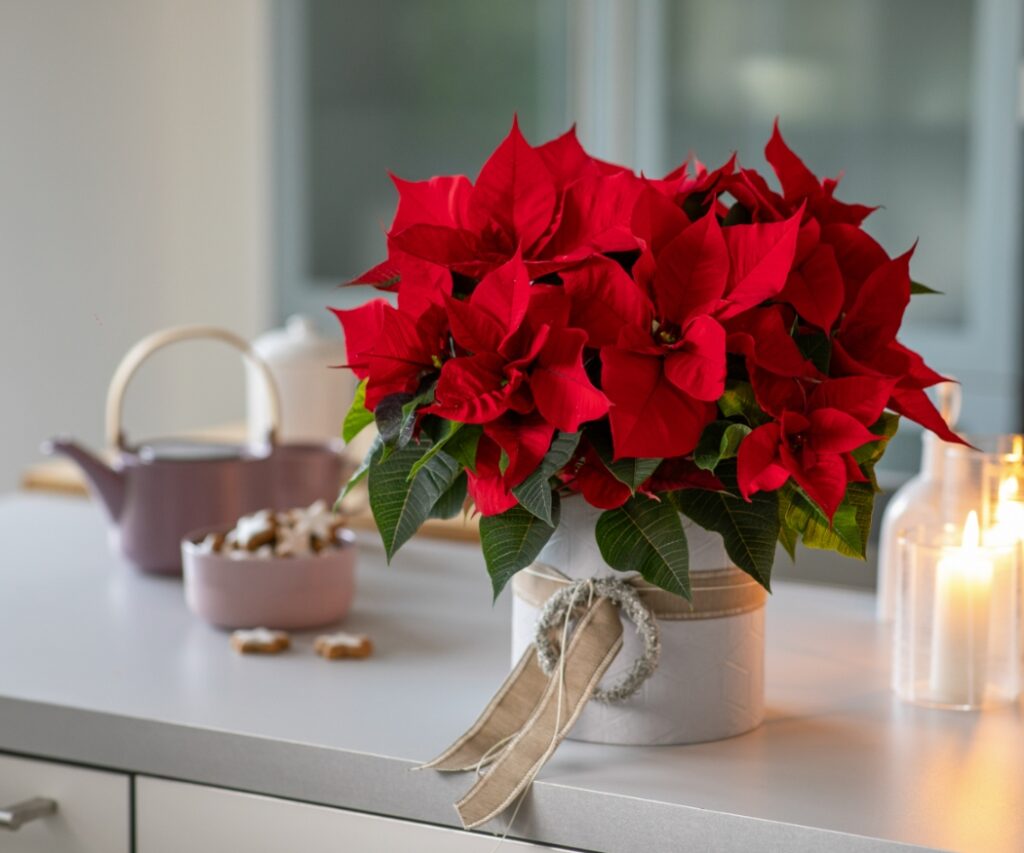
The poinsettia (botanical name: Euphorbia pulcherrima), also known as the Christmas Star/poinsettia, Advent Star or Star of Love, is one of the most popular houseplants during the festive season in many countries. Its striking, star-shaped bracts make it an eyecatching festive symbol.
It brings light and joy to winter
The name Christmas Star comes from the characteristic star-like shape of the bracts and the timing of their appearance – they turn a magnificent red just in time for Christmas. For many people today, the poinsettia represents the essence of this time of year: human closeness, warmth and a vibrant touch of colour that brings light and joy to the dark winter months, making this plant combine decorative beauty with deep symbolic meaning.
The symbolism of the colours red and green
The original colours of the poinsettia — the bright red of its bracts and the deep green of its leaves — are inextricably linked with Christmas worldwide. In many cultures, the vibrant red symbolises love and life, and in the Christian tradition, it represents the blood of Christ. The colour evokes warmth and friendship and is also a symbol of the lives and sacrifices of martyrs. The poinsettia’s red accents are reflected in many Christmas traditions, such as the colour of St Nicholas’s/Father Christmas’s/Santa Claus’s clothing and the red apples that adorn Christmas trees.
A symbol of vitality and optimism
The rich green of the leaves, on the other hand, is considered a symbol of hope, renewal and eternal life. During the dark winter months in particular, the poinsettia’s green foliage serves as a reminder of vitality and optimism. It recalls the promise of new life and hope and helps us remember that even in times of cold and dark, new life can flourish and hope can endure.
The Star of Bethlehem: Symbolism and origin
As well as the plant, there is another significant Christmas star; the Star of Bethlehem. According to the biblical Christmas story, a group of wise men followed a bright star in the sky. This star led them to the birthplace of Jesus. ‘And behold, the star which they had seen in the East went before them until it came to rest over the place where the young child was.’ (Matthew 2:9) Over the centuries, this star has become a powerful symbol of hope, guidance and divine light.
Note on the Christmas miracle
The name of the plant is also inspired by this story. The star-shaped bracts of the poinsettia resemble the sign in the sky, making the plant a symbol of the Christmas miracle. It represents the Star of Bethlehem, which united people and brought light to dark times.
The legend of Pepita
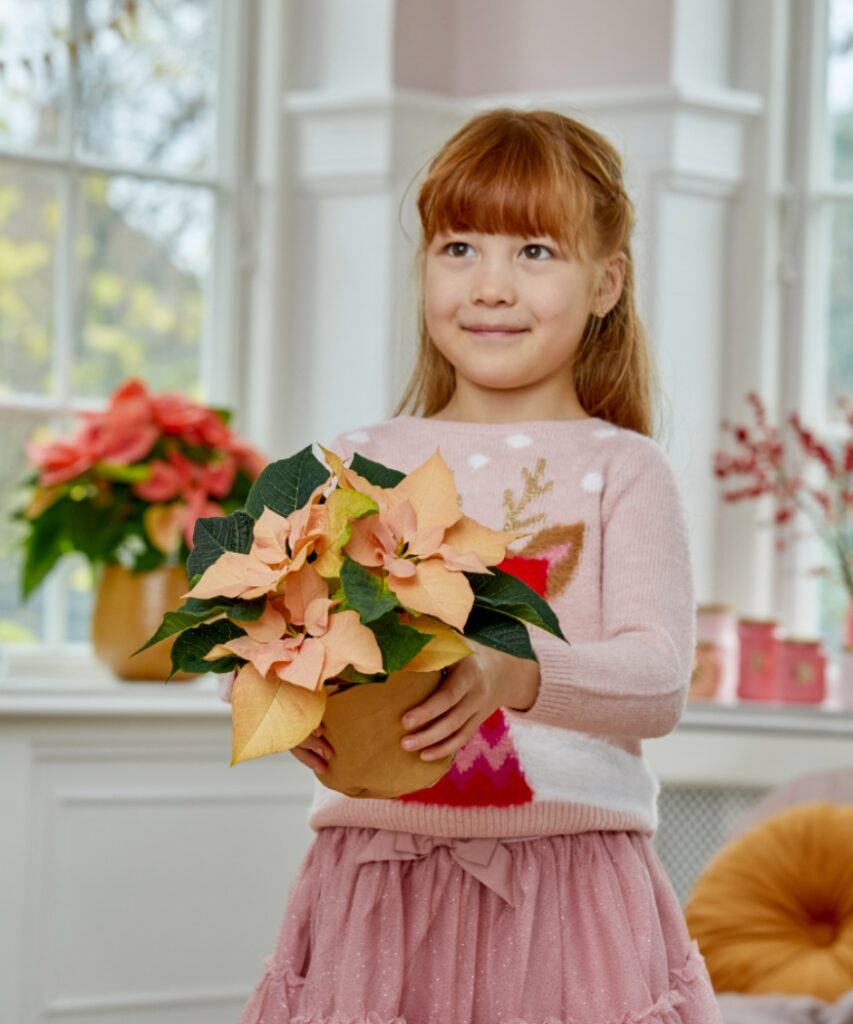
The poinsettia originally grew in Mexico, where it is known as ‘Flor de Nochebuena’, meaning ‘Holy Night/Christmas Eve Flower’. A well-known story tells the tale of a girl named Pepita. She was very poor and had nothing, not even food. Sometimes she didn’t know where she would find a piece of bread or a drink of water, or how she would survive the next few days.
A poor girl’s gift
One day, Pepita heard that a very special child had been born nearby. It had been born in a manger. She decided she wanted to give this child a gift but she had nothing to give, so she picked some plants from the side of the road, took them to the child and placed them in the manger. As soon as she did so, lush, deep red blossoms sprouted from the stems.
This legend has various versions
The plants were beautiful to behold. They made a wonderful gift for the child in the manger, and from that day on, the plant Pepita had picked was called ‘Flor de Nochebuena’ (Holy Night/Christmas Eve Flower). This story about Pepita and the Flor de Nochebuena is a traditional Mexican Christmas tale. There are many versions, each with their own variations. In some versions, Pepita goes to a church instead of the manger. Sometimes she gathers grass or scatters seeds.
Closely linked to Holy Night/Christmas Eve
One thing that always remains the same in the story is that Pepita gives away or sows a humble plant, and suddenly a beautiful ‘flower’ with red petals blooms. The plant in question is the poinsettia, and this Christmas miracle story has made them more closely linked to Christmas Eve than ever before.
Pepito and the Poinsettia
A modern version of the story for children is Pepito and the Poinsettia. It goes like this: Pepito lives high up in the mountains of Mexico. Like all children, he loves Christmas. But this year, Pepito isn’t feeling very cheerful. His little sister is ill and his father has just lost his job. There won’t be any presents. Then he hears about Reina, the queen of the poinsettias. A strange apparition whispers to him that if he finds and picks this flower, he will be granted three wishes. So Pepito sets out on a perilous journey, facing many adventures along the way.
🔈 Free mini audiobook for Christmas: Pepito and the Poinsettia
The goddess who died of a broken heart
Another legend tells of an Aztec goddess who died of a broken heart. She perished from grief, and it is said that wherever her tears touched the earth, plants with red ‘flowers’ grew. This legend may explain the vibrant red of the bracts: a symbol of love and pain. The legend spread to Europe, where the plant became known as the ‘Star of Love’ (Etoile d’amour) in French royal courts.
The meaning of poinsettias around the world

Poinsettias are closely associated with Christmas, not only in their place of origin, Mexico, but also around the world. Their natural red and green are classic Christmas colours, and they also have star-shaped bracts which is why they also symbolise this special season in many other countries.
Germany
in Germany, the poinsettia is a popular gift during Advent and Christmas. Here, it symbolises love, gratitude, and goodwill. During the dark, cold winter months especially, the bright poinsettia is said to bring hope, confidence, and festive warmth into the home. Whether used as table or window decorations or given as gifts to family, friends and colleagues, the poinsettia is an essential part of the German festive season, spreading joy every year.
🔗 How to make a gift of mini poinsettias
Great Britain
In Great Britain, the poinsettia is a popular Christmas decoration, often adorning windowsills, dining tables and churches. There, the plant primarily symbolises festive joy, hospitality and the magic of Christmas. Poinsettias are also a popular gift to give during winter visits, as a thank-you to hosts for their hospitality.
France
In France, the poinsettia is called ‘Étoile de Noël’ or, more poetically, ‘Étoile d’Amour’, meaning ‘Star of Love’. The plant is associated with various legends, often involving miracles and charity. During the festive season, poinsettias can be found in many homes, symbolising love, happiness and the light Christmas brings to the world.
🔗 10 reasons why poinsettias make Advent extra special
Italy
In Italy, the poinsettia is known as the ‘Stella di Natale’. Many families use the plant as a festive table centrepiece or colourful way to decorate a room, especially at Christmastime. It is considered a symbol of hope, prosperity and new beginnings — values associated with the birth of Christ. Poinsettias are also used to decorate churches and town squares.
Spain and the Canary Islands
In Spain and the Canary Islands, the poinsettia is known as the ‘Flor de Pascua’ (Easter Flower) or the ‘Estrella de Navidad’ (Christmas Star). In many Spanish-speaking countries, ‘Pascua’ refers to the broader period of festivities around both Christmas and Easter. Throughout Advent and Christmas, these vibrant plants form part of public and private festive decorations. In many places, poinsettias are also planted outdoors, filling squares and streets with festive red.
Scandinavia
In Sweden and other Scandinavian countries, the poinsettia is known as Julstjärna (Christmas star). Here, it primarily represents light and hope. During the long winter nights in the dark north, it is an important symbol. An integral part of traditional Advent decorations, it is often given as a gift to friends and family.
🔗 Making Christmas decorations: Five creative craft ideas
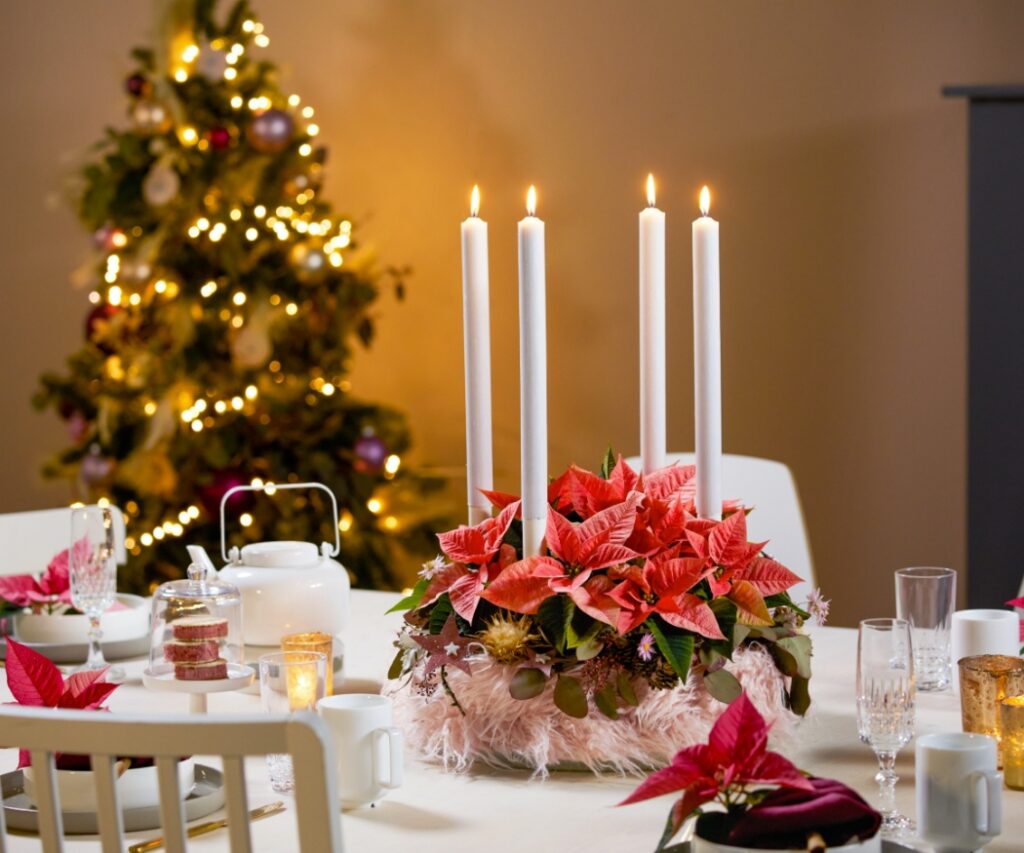
Eastern Europe
The poinsettia is also commonly used to decorate homes for Christmas in many Eastern European countries. It often symbolises the Star of Bethlehem, which, in Christian tradition, is said to have guided the Three Wise Men to the manger. Its deep red colour is significant, representing love, Christ’s sacrifice and hope for new life.
Latin America
Outside of Mexico, the poinsettia has become widespread in Latin American culture. In many places, the plant is seen as a universal symbol of Christmas, and its colours represent joy, hope and new beginnings during celebrations of the birth of Christ. In the continent’s predominantly Catholic countries, the poinsettia is used as a festive church decoration.
🔗 From Aztec star to worldwide Christmas symbol
USA
Poinsettias are popular gifts in America. There’s even an official Poinsettia Day on December 12. On this date, friends and family give each other poinsettias. Poinsettia Day is also becoming increasingly popular in Europe.
The poinsettia: Its origin, name and history
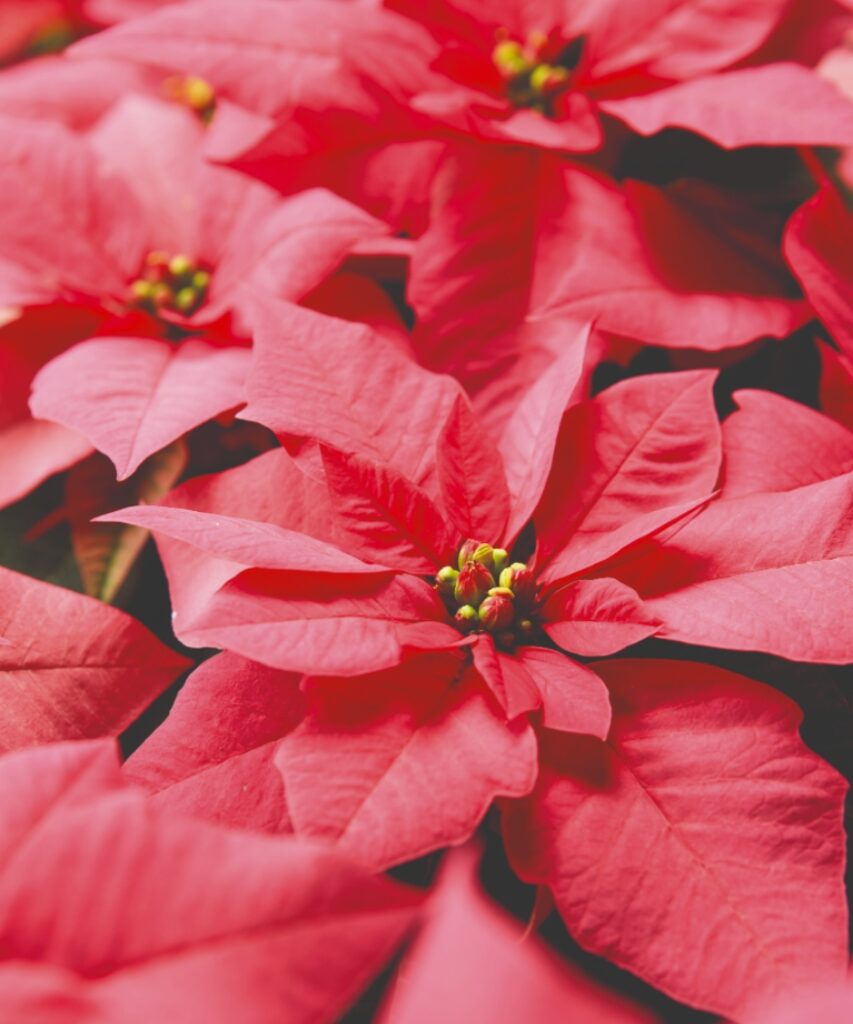
The poinsettia (bot. Euphorbia pulcherrima) is native to Mexico. There, it grows as a shrub reaching up to 5m high on sunny slopes. The Aztecs held the poinsettia in high regard, which is why it is also known as the ‘Star of the Aztecs’. They called it ‘cuetlaxōchitl’, meaning ‘leather flower’.
According to tradition, Cuitlaxochitl was the favourite flower of the last Aztec ruler, Moctezuma II (1480–1520). He supposedly had it brought to his capital, present-day Mexico City, where poinsettias do not grow in the wild due to the high altitude.
Medicinal plant and offering
In Aztec culture, the red bracts were used as a dye and a remedy for fevers. The poinsettia also played a role in religious ceremonies. The Aztecs used it to decorate ritual offerings and honour the god of light, Nanahuatzin. The plant was considered a symbol of purity and a sign of new life for warriors killed in battle.
Missionaries give it a new name
After the Spanish conquest, the plant was named ‘Estrella de Navidad’ by missionaries. The poinsettia first appeared in a procession of Franciscan monks near Taxco in the 17th century. From then on, the plant became an increasingly important Christian symbol, known as ‘Flor de Nochebuena’, or ‘Holy Night/Christmas Eve Flower’.
From cuetlaxōchitl to poinsettia
In 1828, Joel Roberts Poinsett, an American politician, physician and amateur botanist, introduced the poinsettia to the United States. He had discovered the plant in the region around Taxco while serving as ambassador to Mexico (1825–1830). Enchanted by its vibrant red, he brought cuttings back to the United States. There, the plant was named after him.
A triumphant march through the USA
The plant was soon cultivated and first exhibited at the Philadelphia Flower Show in 1829. From there, it began its triumphant journey across the USA, later spreading to Europe. Over the course of the 19th century, it quickly spread throughout America. In warm regions such as California, poinsettias were often grown outdoors. In 1834, plant dealer Robert Buist exported the first poinsettias from the Bartram Botanical Garden in Philadelphia to Europe.
Following Poinsett’s death in 1851, the US Congress declared December 12 a day in his honour, now known as Poinsettia Day. The botanical name, Euphorbia pulcherrima, is also fitting, meaning, ‘the most beautiful spurge’.
It was discovered earlier, but almost forgotten
What few people know is that European botanists discovered the poinsettia before Poinsett did. Between 1787 and 1803, the Spanish physician Martín de Sessé y Lacasta and the Mexican botanist José Mariano Mociño travelled throughout Mexico. Their aim was to scientifically record the flora and fauna of New Spain.
This expedition, known as the ‘Royal Botanical Expedition to New Spain’, documented the poinsettia for the first time in Europe. The two researchers collected plant specimens, drying and pressing them for the herbarium, and creating the oldest known illustration of the species in the process. Some of these original specimens are still preserved in the Botanical Garden in Madrid today, where they are known as Euphorbia fastuosa.
A wild shrub becomes a Christmas classic
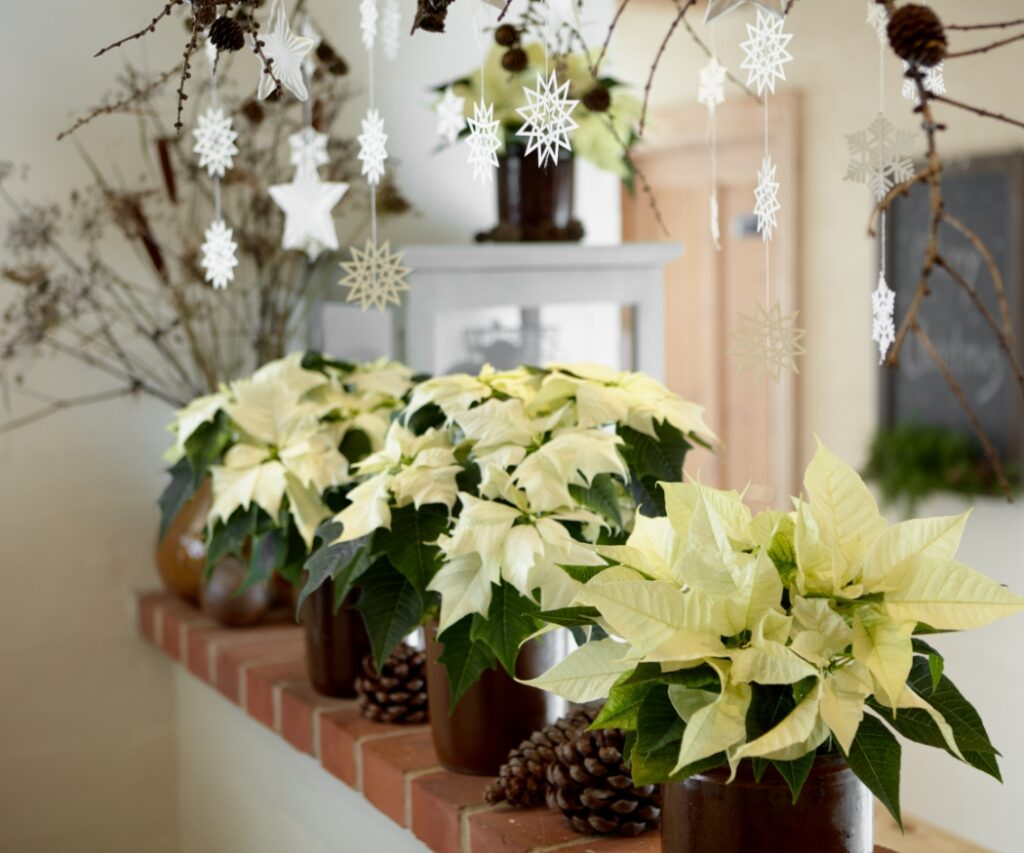
In the 1950s, the Paul Ecke Ranch nursery in California popularised the poinsettia worldwide. Initially, they sold its stems, which grew wild, as cut flowers on Hollywood Boulevard at Christmastime. Later, the Ecke family bred new varieties that were smaller, bushier and more hardy — perfect for living rooms. They also advertised the plant on television and sent it to major department stores across the USA as decorations. So the poinsettia gradually became an integral part of the festive season, first in America and then in Europe.
Today, they are more colourful and diverse than ever
Poinsettias are now available in a variety of colours and sizes, ranging from classic red to white, pink, apricot, and speckled types. Whether you want a small plant for the table or a single large specimen to decorate a room, there’s something for every taste. Poinsettias suit both traditional and modern, sustainable or creative decorating ideas.
Locally grown poinsettias: Good for you and the environment
Nowadays, many people are interested in knowing where their Christmas decorations come from. The poinsettias available in Europe are grown in local nurseries. This has many advantages; transport distances are shorter, less CO₂ is produced and the plants are often fresher. What’s more, buying a locally grown plant supports local businesses. This makes poinsettias a good fit for a modern, sustainable home.
What does the poinsettia mean today?
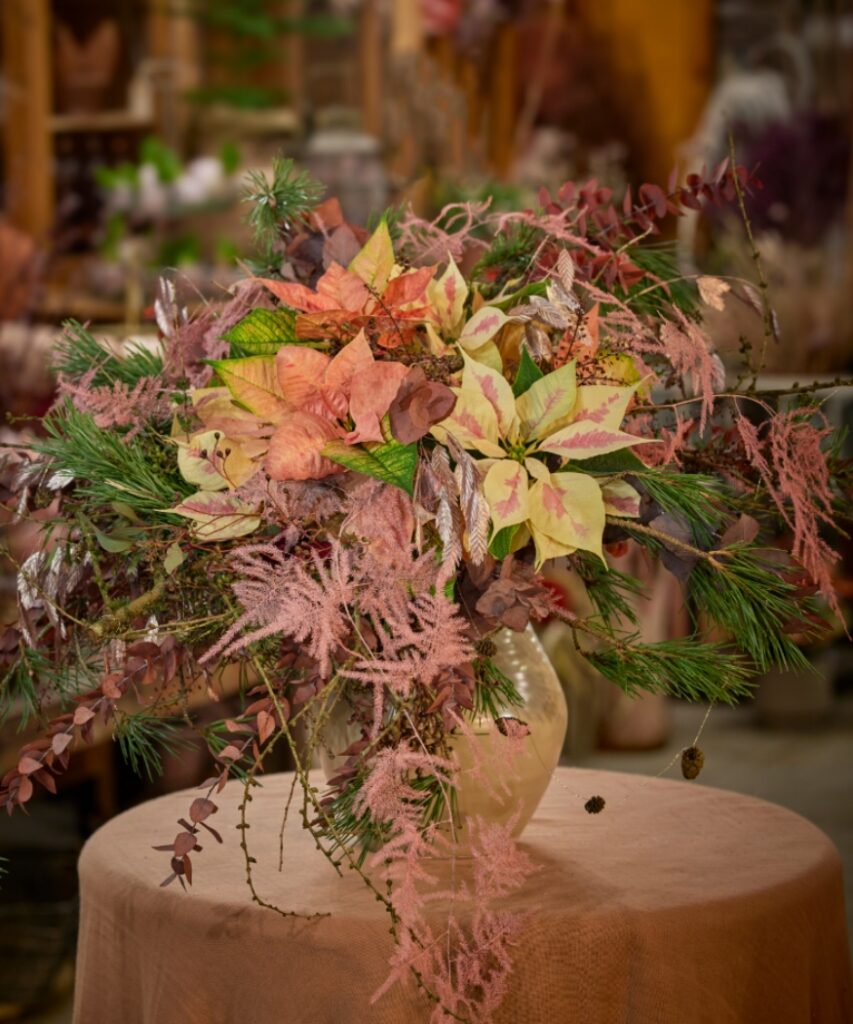
Now more than ever, the poinsettia is a versatile symbol, open to many interpretations and lifestyles. It’s adaptable; sometimes it stands out as a modern design statement and a splash of colour in homes; sometimes it creates a classic Christmas atmosphere; sometimes it’s part of autumn or winter décor; and sometimes it’s simply a personal favourite on the windowsill. Regardless of tradition or faith, those who place a poinsettia in their home are making a personal statement.
Society in transition – room for personal interpretations
For religious families, the poinsettia often represents the Star of Bethlehem, symbolising light and divine guidance, particularly at Christmas. In churches and other religious places, it is an integral part of Christmas decorations and a reminder of the biblical story. Others associate more general values with the plant, seeing it as a symbol of joy and wellbeing, and of the search for warmth in winter, transcending religious customs.
A simple, easy-care, plant favourite for everyone
Some people simply appreciate it as a beautiful, low-maintenance houseplant, devoid of any symbolism. It is long-lasting, easy to look after and can bring weeks of joy. Today, the poinsettia thrives thanks to its versatility. Whether as a spiritual symbol, festive decoration, modern home accessory or a touch of nature in winter, its meaning is up to you.
Giving a poinsettia as a gift: A symbolic present
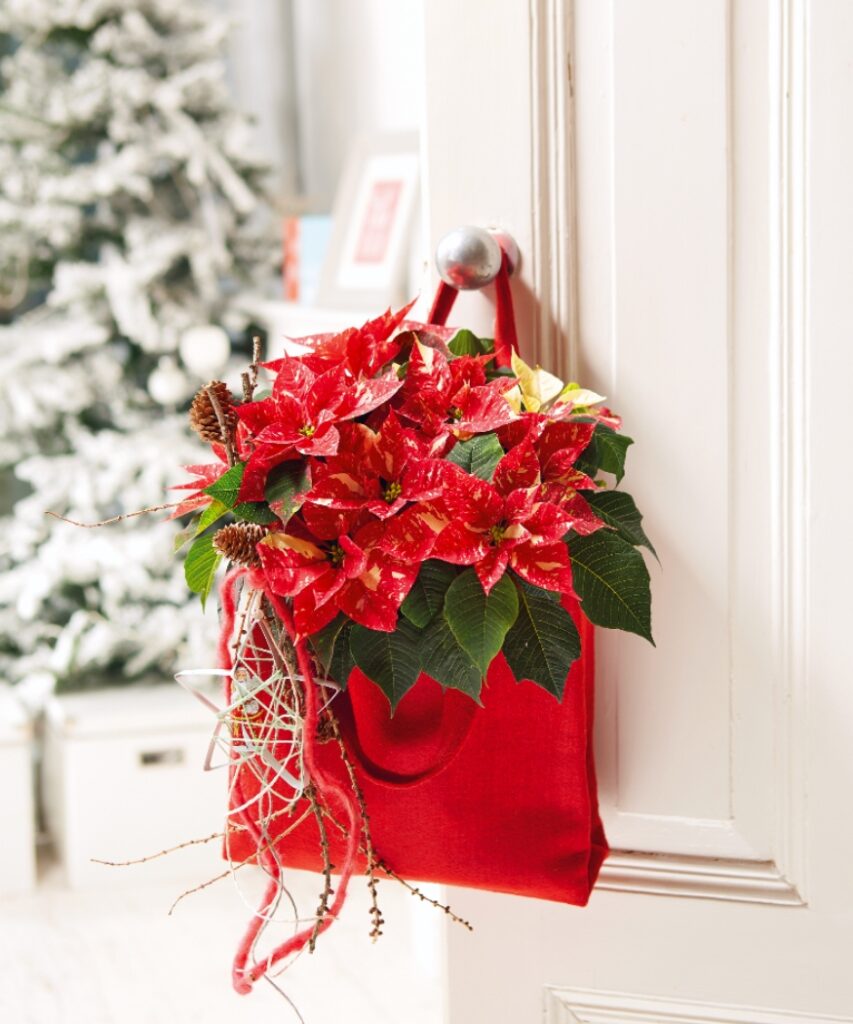
A poinsettia is the perfect gift for Advent and Christmas. Its bright colours and symbolic significance make it a wonderful choice. Poinsettias are often carefully selected, beautifully packaged and presented with love as a small token of appreciation, thank you or expression of affection.
Express what you want to say
The variety or colour you choose can have its own meaning: For example, a pale pink poinsettia represents lightness and freshness; a white one, calm and clarity; and a red one, warmth and friendship. The design of the pot, packaging and greeting card also convey meaning.
Everyone is happy – guaranteed
For some, it’s an annual tradition to give poinsettias as gifts to family and friends, or to take to the office during Advent, when visiting relatives, or as a small souvenir. Others choose to give a poinsettia because it lasts longer than a bouquet of flowers.
What makes a poinsettia such a special gift?
- They are easy to obtain, from a florist or nursery, for example. Yet it remains special, and is by no means ordinary.
- As a potted plant, it doesn’t need a vase. It arrives ‘ready-made’ and can be placed anywhere instantly.
- Poinsettias are easy to look after, and with a little care they will look beautiful for weeks or even months, often well beyond the festive season.
- Thanks to the wide range of colours, shapes, sizes and pots, you can choose one to suit individual tastes. They work with any style of interior or budget and can convey a specific message or mood.
👉Want to know more about Poinsettia Day?
On December 12, poinsettias are traditionally given as gifts in the USA and, increasingly, in other countries too – as tokens of love, thank-you gifts, or gestures of apology. In this blog, we explain how this tradition originated, what it means, and how you can easily personalise a poinsettia.
🔗 Read our blog about Poinsettia Day
The poinsettia: Perfect for our times
When well looked-after, poinsettias can last throughout the winter, providing a long-lasting touch of beauty and symbolism. Regionally produced poinsettias, especially, represent quality; they are carefully grown, expertly transported and bred to be hardy and beautiful, bringing a positive environmental impact to your home.
Controlled cultivation:
The plants are grown in modern greenhouses with targeted lighting. This enables them to develop strong roots, sturdy stems and evenly coloured bracts.
Environmental standards:
The EU has clear guidelines for plant protection and production conditions. Many companies also adhere to voluntary environmental standards or obtain certification.
Short transport routes:
Reduced travel distances mean less stress for the plant and lower CO₂ emissions.
European-standardised varieties:
Poinsettias bred for the European market are compact, hardy and adapted to indoor climates. They are ideal for heated homes
💡 Tip: Ask your retailer about its poinsettia producer. Many nurseries ship plants directly to retail outlets. You can often identify these growers by the pot label or signs placed onsite.
Poinsettias as decoration: ideas for the home
Classic and festive

To create a traditional Christmas feel, choose a large red poinsettia in a planter. Combined with evergreen branches, candles and nuts, it makes a wonderful Advent decoration for a sideboard, nativity scene or windowsill.
Scandi and minimalist
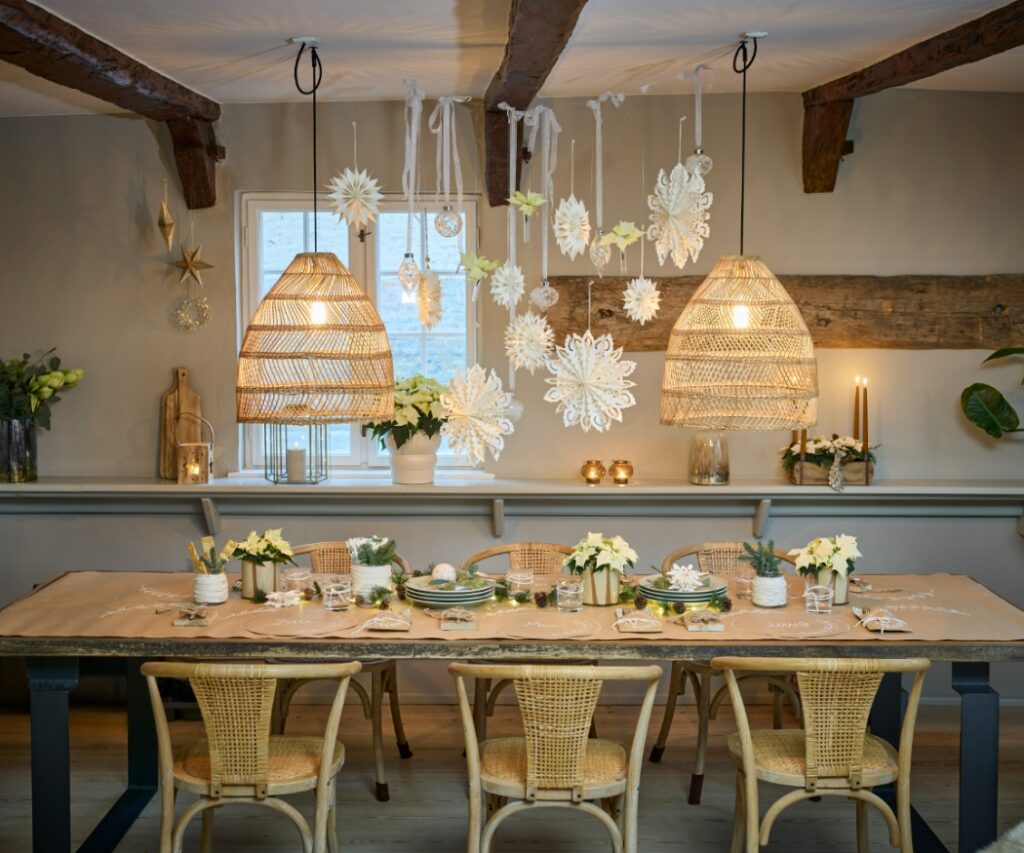
White or cream poinsettia varieties are ideal for creating a calm, airy interior. They look understated in simple ceramic pots on pale wooden surfaces. Complemented with eucalyptus, dried flowers or a paper star, poinsettias can be incorporated into a natural, modern aesthetic.
Creative and playful
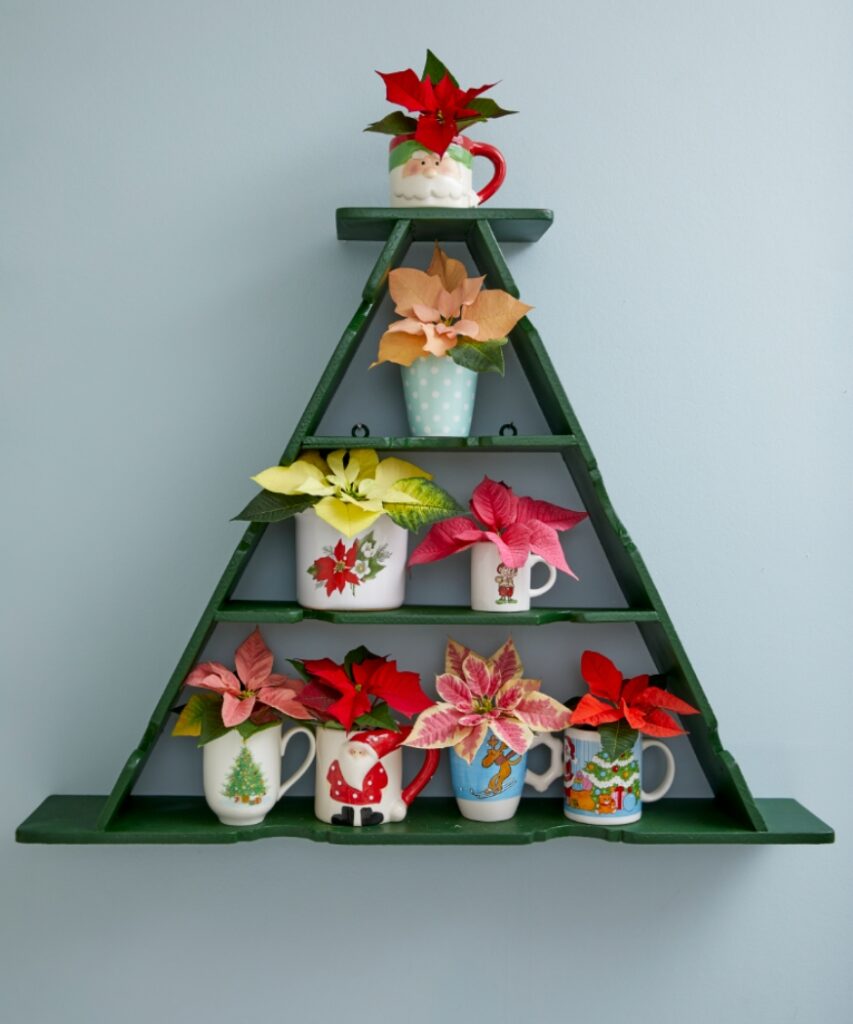
Colour lovers can choose from salmon, pale pink or speckled varieties. Place little poinsettias on the table to add a splash of colour, either in an old cup or on a plate, as a gift. Even mini poinsettias on a shelf can brighten up everyday life.
Striking and urban

Poinsettias look great in black or metal pots in homes with clean lines and modern materials such as concrete, steel, or glass. They also make a great statement when paired with lush, green foliage plants.
Sustainable and conscious
If you value environmental friendliness, use pots made from ceramics, wood or recycled materials. Buying plants and decorative items made from natural, locally sourced materials can help achieve ecological goals.
Care and durability tips: how to keep your poinsettia looking beautiful for longer
Protect them well on the way home
Poinsettias are sensitive to cold. Even temperatures below 12°C can cause damage. So make sure you wrap them up well — in paper, for example — on the journey home and avoid leaving them outside for long periods or in a car.
A suitable location: Bright and warm
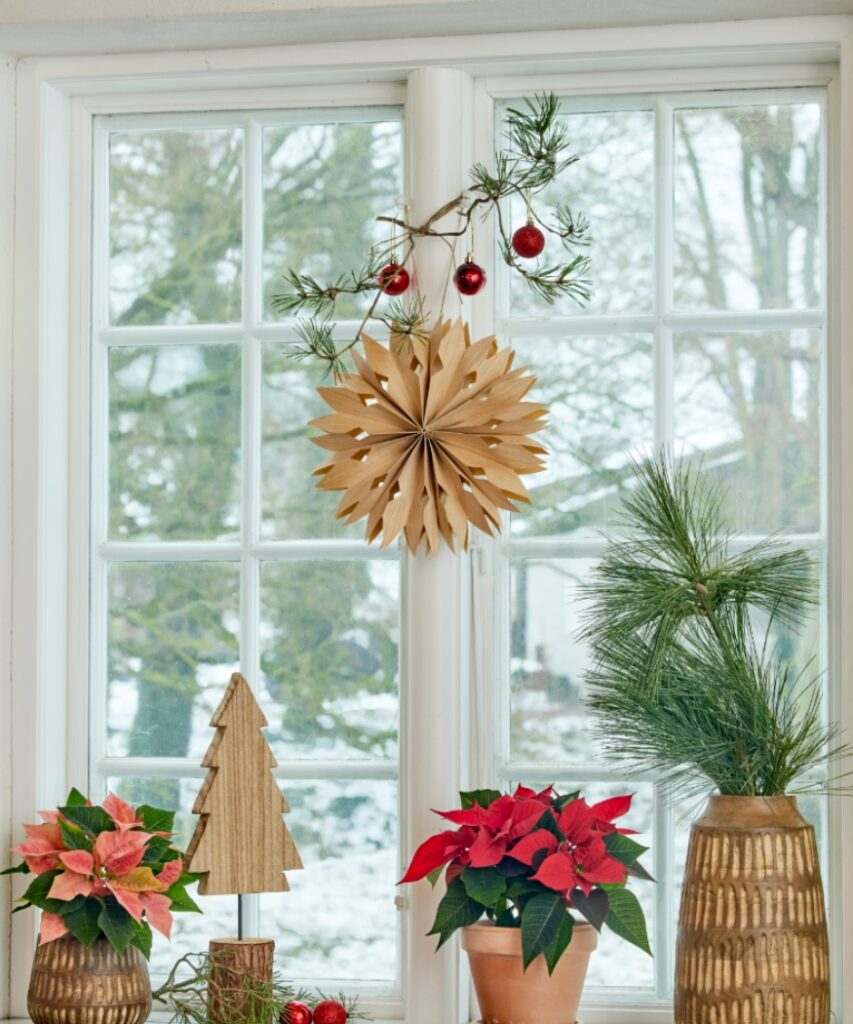
Poinsettias prefer bright conditions but should be kept away from draughts. A spot by the window is ideal, provided cold air isn’t seeping in through any cracks. If possible, the plant’s leaves should not touch the windowpanes. Using a saucer can help prevent the roots from getting cold. Direct sources of heat, such as radiators or fireplaces, should be avoided.
🔗 Poinsettia location check: Which 3 factors really matter?
Water sparingly, but correctly
Only water when the soil feels dry. Instead of watering from above, try from below. If necessary, place the pot in a bowl of water until bubbles stop appearing. Important: allow the plant to drain well afterwards and avoid standing water in the planter.
Check the room temperature
Poinsettias thrive at normal room temperature, which is between 15 and 22°C and they don’t like extreme temperature fluctuations. If in doubt, keep them in a cooler room, such as a bedroom, rather than an overheated living room.
Longer enjoyment – sustainable thinking
A well-cared-for poinsettia lasts significantly longer than a bouquet, often until the new year and beyond. You can even keep it over the summer and make it bloom again the following winter. This makes the plant a beautiful and sustainable choice.
👉Find detailed care instructions in this blog:
🔗 Caring for a poinsettia – click here. ➡️
Poinsettias with a difference: colours, shapes and new ideas
The poinsettia has long been more than just deep red and traditional. Modern varieties offer a wide range of colours, shapes, and styles. Today, poinsettias are available in colours such as cream, white, pale pink, salmon, apricot and lemon yellow, as well as multicoloured varieties with speckled or marbled patterns reminiscent of watercolours. Each colour tells its own story!
Whether you want something impressive for a hallway or something smaller for a shelf, poinsettias come in many sizes and growth habits. They can be compact or sprawling, grown individually or in arrangements. They are as versatile as your home.
New ideas: A rethink and fresh combinations
Why not plant two poinsettias of different colours in one arrangement? Or arrange several miniatures as a table centrepiece? Poinsettias also look great in hanging baskets, vintage containers or modern decorative bowls. Get creative and turn your plant into a design object!
What type of poinsettia are you?
- Your favourite Christmas colour is…
A) Red, as usual
B) White or cream – calm and crisp
C) Pale pink, salmon or something playful
D) Metallic or black – contrast is key - Your decorations tend to be…
A) Traditional – nativity scene, evergreen branches and candles
B) Scandi – wood, linen and paper stars
C) Creative – crafted, vintage items, unusual containers
D) Minimalist, but a statement - The gifts you give are…
A) Poinsettias every year – it’s tradition
B) Personally selected – preferably locally sourced
C) Surprisingly and creatively packaged
D) A limited number, but chosen with care – quality over quantity
✨ Answers:
Mostly A – The Classic
For you, Christmas is red, warm and emotional. The poinsettia is a symbol of childhood for you and a must-have for your sideboard.
Mostly B: The Calm Type
You like things to be clean, minimalist and harmonious. A white or cream poinsettia would fit perfectly in your tidy home.
Mostly C – The Playful Type
You love variety and little surprises. For you, poinsettias can be pink or speckled and can even live in a teacup.
Mostly D – The Style-Conscious Type
You think in terms of lines and contrasts. For you, the poinsettia is a design object, intentionally placed and far from kitsch.
👉 No matter what kind of person you are, your poinsettia can reflect your personality.
For more inspiration, check out these creative decorating ideas:
🔗 Find creative decorating ideas here
FAQs about poinsettias
Why do people give poinsettias as gifts?
They are a popular gift during Advent. They look beautiful, last a long time and show, ‘I was thinking of you’. People often give them as a thank-you, a gesture of apology, or simply because they like them. The plant symbolises warmth, hope and affection. This is exactly what many people want to express at Christmas. December 12 is Poinsettia Day, a date on which poinsettias are traditionally given as gifts.
Do the Three Wise Men have anything to do with poinsettias?
Not directly, but there is a connection. According to the Bible, the Three Wise Men followed a star in the sky that led them to the manger. This star is often referred to as the Star of Bethlehem. With its shape and name – the Christmas Star – the poinsettia is reminiscent of this celestial body. So, it’s a fitting symbol of Christmas and is also seen as a tradition in Christian households.
Is the poinsettia a symbol of Jesus?
While it is not an official symbol of Jesus Christ, the poinsettia has a strong connection to the Christmas story. It represents hope and divine guidance, just as the star that led people to the birthplace of Jesus is said to have done in the Bible. For this reason, many churches use it as a festive plant. The colours also have meaning: red represents love and the blood of Christ, while green represents eternal life. For many people, the poinsettia is therefore more than just a beautiful plant.
Why are there plants and stars called the Christmas Star?
The star in the sky is also called the Christmas Star because, according to the Christmas story, it guided the Three Wise Men to the manger. The plant gets its name because it produces its red bracts at Christmastime, which look like shining stars. That’s why it was given the same name. So the name Christmas Star (poinsettia) refers to two things: the heavenly symbol and the beautiful plant.
Are poinsettias poisonous?
Poinsettias belong to the Euphorbiaceae family. Like many other plants in this group, they secrete a white, milky sap when damaged. In the wild, this juice contains irritating substances. However, modern varieties, such as those commonly sold as houseplants today, no longer contain these substances in their sap, meaning poinsettias are generally considered safe for humans. Nevertheless, the plant should not be eaten.
The sap can irritate very sensitive skin. People with a latex allergy should exercise caution, as there is evidence of possible adverse reactions. There are no conclusive studies on how sensitive dogs, cats or birds are to poinsettias, but consumption may cause problems, so keep poinsettias out of reach of pets.
Is the poinsettia a religious symbol?
Yes, for many people, it still has religious significance today. In Christian homes and churches, it often represents faith, love and hope. It can also be used simply as a beautiful, festive decoration.
How would a poinsettia fit my decor?
The poinsettia is very versatile, so it suits many different interior styles. The classic red variety creates a warm and festive effect. White or cream varieties complement a modern, Scandi aesthetic, while more unusual colours such as pale pink, salmon, and multicoloured speckled or mottled varieties are also available for a more creative look. With the right planter and accessories, as well as some natural décor, poinsettias can become real eyecatchers – no matter how you live.
How can I incorporate poinsettias into my décor in a meaningful way?
Combine them with candles (light), evergreen branches (nature) and personal items (memories). This transforms a simple decorative plant into a display with meaning.
What does each poinsettia colour represent?
Red: Love, tradition
Yellow: Optimism and joy
Pale pink: Romance and femininity
Hot pink: Creativity and happiness
Apricot: Freshness and joy
White/cream: Tranquillity and innocence
Are there any poinsettia rituals?
In some families, putting out a poinsettia is part of their festive Advent tradition, much like an wreath or calendar.
🔗 New tradition: Children make a Christmas village with poinsettias
How do you look after a poinsettia properly?
They need a bright, warm spot, but away from draughts and cold. When watering, ensure the soil does not become overly wet. When watering, it’s better to submerge the plant than to water it from above. Always avoid overwatering. Poinsettias prefer room temperatures between 15 and 22°C. With proper care, your plant will look beautiful for weeks, often well into the new year.
🔗Find detailed care instructions here.
Does giving a poinsettia as a gift have a particular meaning?
Yes, the poinsettia symbolises warmth and appreciation. Giving one as a gift says: ‘You are important to me.’ This is a lovely gesture, especially during Advent, and can be given as a thank-you, a token of love or a gesture of apology. December 12 is celebrated as Poinsettia Day in many countries, when these plants are traditionally given as gifts. It’s a beautiful custom that highlights the emotional significance of poinsettias.
How long does a poinsettia last?
With the right care, a poinsettia can last for many weeks, well into spring. It’s important to protect it from cold, water it regularly but sparingly, and position it correctly. If it stays healthy, you can continue caring for it throughout the year. With a little patience, it will produce colourful bracts again next winter. This turns a seasonal plant into a long-term companion.
What is the difference between the Christmas Star (poinsettia) plant and the celestial body known as the Christmas Star?
The word ‘Christmas Star’ can refer to either the plant (Euphorbia pulcherrima) or the Star of Bethlehem. The celestial body is a key part of the biblical Christmas story, acting as a guiding light for the wise men to the manger. The plant got its name because the shape of its colourful bracts resembles a star, and they appear at Christmastime. Both star symbols represent guidance and hope in different ways.
Want to learn more about poinsettias and get some great inspiration?
Check out our care instructions and decorating tips, then follow us on Facebook, Instagram, Pinterest or YouTube!
 English
English Dansk
Dansk Deutsch
Deutsch English
English Español
Español Français
Français Hrvatski
Hrvatski Italiano
Italiano Magyar
Magyar Nederlands
Nederlands Norsk
Norsk Polski
Polski Română
Română Slovenský
Slovenský Slovenščina
Slovenščina Suomi
Suomi Svenska
Svenska Čeština
Čeština Ελληνική
Ελληνική Български
Български
